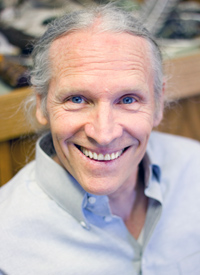Eric Larsen

Eric Larsen is a Fluvial Geomorphologist from the University of California at Davis who worked with the Yolo County Board of Supervisors on their Technical Advisory Committee. He studies the morphology of the earth and more specifically the natural processes and forms of rivers and streams like Cache Creek
“When I do restoration work, I like to think of myself as a river doctor. I try to understand the forces in water and how those forces interact with the earth -meaning the soil, banks and vegetation. How rivers shape themselves is something that most people don’t understand particularly in a watershed like this — and not understanding causes conflicts where I don’t think they need to be.”
What are some of the challenges that are faced by the demands of gravel mining?
In 1995, the creek was changing its nature because of the amount of gravel that was being taken out. So much gravel was being extracted that bridge piers were starting to erode 10 to 12 feet. The bed of the stream was going down, because more gravel was being taken out than was coming in. So in the “accord” that happened in 1995, there was a balance proposed: the amount taken out shouldn’t exceed the amount coming in.
You talk about the different ways of working with the creek; is there an ideal way?
Every time I hear someone say that the creek is threatening this or that, I want to correct them. Actually, the creek is not threatening anything. Some of what creeks do is in conflict with what people want to do. Now, conflict is not wrong; conflict is a part of life and of growing. When you have a conflict, to say the creek has a problem is an error. What there is, is a conflict between the activities of the creek and the activities of people. My own opinion is that people don’t understand the natural dynamics of the creek well enough to deal with that conflict… To me that’s the biggest issue: understanding the natural processes that occur in the creek, understanding the needs of agriculture, aggregate mining, and whoever else has interests in the creek. Taking all of these things into account and then finding some way to work together.
How do you decide what you restore? What’s your baseline for restoration? How far back do you go?
[I]f there is one thing that I focus on, it’s restoring the process of the creek, because the creek is going to take its own form. If you focus on restoring the process, then the form naturally follows. You can’t do one without the other. The way people have riprapped rivers— when you put rocks on the side of the bank to hold it in place— and put all sorts of things in rivers to keep them from doing what creeks do anyway can be counterproductive and can cost millions of dollars. It leads to what a friend of mine calls “serial engineering”, in which people engineer a so-called solution to a problem, and then they have to engineer a solution to the problems caused by the original engineered fix. These are problems that we are now recognizing with how people have worked with creeks and rivers all over the world, including Cache Creek. Sometimes you restore the form in order to restore the process but to me the process is most important.
Is mining gravel part of the process?
Historically, the area was a big gravel fan, which is an area where gravel deposits and spreads out over the landscape in the shape of a fan. I know in the old days, in order to cross the creek people had to go a full mile through ponds and gravel bars from one side to another. I’m ok with not having to drive a full mile through ponds to get from one side to the other. So we need bridges, and the creek needs to be a little narrower than it might have been 1,000 years ago. The fact that it is narrower means that you can remove some gravel because you don’t have that big fan on which to deposit gravel anymore. So it’s probably good for the creek for some of the gravel to have been removed from the main channel. But too much was taken out.
Is there a place for humans, gravel mining and agriculture with the Creek?
I believe that these various interests can exist together like a family working together. This would include a certain amount of gravel mining, a certain amount of agriculture, a certain amount of water extraction, and the creek having a very dynamic process. I think all of those are possible together… They all have different needs: agriculture, aggregate mining, and the creek. But those needs can work together just like a family can work together. I’m not for letting it all go wild. You have to work with the creek intelligently. Every time a bank starts to erode you don’t necessarily need rip-rap.
So what is interesting or unique about the portion of Cache Creek that runs through this Preserve?
Well there’s nothing particularly unique about the creek itself. The creek with the water and the gravel is fairly characteristic of the reach upstream and downstream. But the Preserve is unique. I think the Preserve acts as a catalyst to bring people together and also to provide information. If people have information they are going to act more responsibly. So not only is this an oasis on the creek for wildlife and vegetation, it is also a crossroads for the interests to meet where people can feel safe, a place to provide information, interest, and connection.
To download the audio, right click on the audio link above and scroll to "Save link as . . ." and choose the directory where you want to store the mp3. In Windows, you may have to use Control + S to select the link.